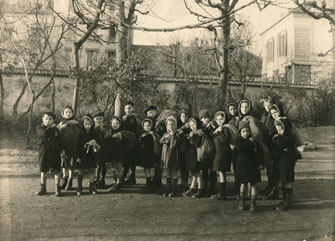
Children absorb and reflect the world of their elders. At Drancy, the internment camp in France from which over 67,000 Jews, 6,000 of them children, were deported to the Nazi extermination camps, “ordinary life sometimes took over,” said Odette Dattroff-Baticle, an internee there in 1943. “The children played, but they had their own games: ‘Search’ and ‘Deportation’.”
That chilling image comes from the new exhibition “C’Etaient des Enfants” at Paris’s Hôtel de Ville, which attempts to conjure the world of the Parisian children whose families were dragged from their homes beginning exactly 70 years ago, in July 1942, by the French police. On that date, the 14,000 Jews arrested were sent to the Vélodrome d’Hiver near Paris for future deportation to Drancy and then onward to Auschwitz.
The exhibition tells the story from the point of view of the children themselves, with photos, drawings, poems, toys, eyewitness testimony and more. Altogether, 11,400 Jewish children, most of them Parisians, were deported from France or died in one of the French internment camps. Only 200 of them returned.
More than one of the exhibits here will sicken you. Here’s a long pale-yellow dress trimmed with burgundy ribbon with an ugly pumpkin-colored star marked “Juif” sewn onto it. Next to it is a photo of its owner, Tauba Szmukler, proudly wearing it – sans yellow star – in a school photo a year before.
Then there’s the poem by 10-year-old Fanny Gicht, a refugee in a home for children in the South of France, comparing her people to toads: “Nature made us so ugly/that everyone is afraid to touch us/But cowardice isn’t afraid/to touch us with its rough hands. It strikes us as if we had done something to it.”
Or how about “Youpino,” a propaganda Dick-and-Jane-style book to teach children about the perfidy of Jews, in which, for example, a Jewish boy cheats at games so he can win more toys.
There are toys made out of wood for their children by fathers interned in camps, paper dolls and drawing books from Drancy and even a beautifully dressed but sad-looking baby doll next to its little suitcase full of clothes. It was one of the few survivors of the looting by the German occupiers of 38,000 Parisian apartments once inhabited by Jews who had fled or been deported. When the family of Francine Christophe returned to their apartment after the war, they found her doll still there—an unusual occurrence, since the Germans usually took everything, right down to the rolls of toilet paper.
The exhibition grew out of a project led by a group of Parisians who wanted to give names to the children who had been deported from the city’s schools and received support for their research from Mayor Bertrand Delanoë.
The “good” news from the exhibition is that around four-fifths of France’s Jewish children survived the war; some escaped with their families, some were helped by aid and resistance networks, some were hidden by individuals or in Catholic institutions (where they were often pressured to convert).
One survivor, François Szulman, who from the age of 12 hid with his family in an apartment on Rue Sainte-Marthe in the 10th arrondissement, was a talented artist who spent his time in hiding drawing his surroundings and forging ration tickets for bread (which the local baker recognized as forgeries but accepted anyway). A number of his drawings are on show, including a couple of his mother, who, unable to seek medical help, died of asthma in hiding in 1943.
Two other survivors, André Kahn and Charles Zelty, 16 and 19, are shown in an especially poignant photo sitting on a hotel bed in Paris after their return from Auschwitz, emaciated, half-dressed, with bandages on their legs, avidly eating from the same plate.
Even those who seemed to have survived unscathed, however, like the woman whose mother told her that as a little girl she hadn’t been affected by the war or even missed her absent father, recognize the invisible scars. “Were there any Jewish children who weren’t ‘marked’?” she asks.
Reader Andy Carpentier writes: “It was very moving to read your post and then go the expo’s own site. What a tragedy! A courageous opening and testimony to such a painful experience for all. Having seen the movie Sarah’s Key, I found this so very poignant.”
Reader Perci Chester writes: “This exhibit ‘C’Etaient des Enfants’ is long overdue, and I really appreciate knowing about it. I have a friend who as an infant in Paris was given to a lady when her parents were deported and only her father survived. He was never quite the same.”
Reader Richard Ewan writes: “There have been many discussions in our household about the French penchant to deny their racial prejudices and refuse to admit this ugly side of humanity. The more exhibits in France of this atrocious behavior by the French as well as Germans the better. It was the French who arrested these citizens for the deportations.”
Reader Bruce Carolan writes: “The only thing missing from the exhibit is any English translation for the many non-Francophones in Paris in summer.”
Favorite